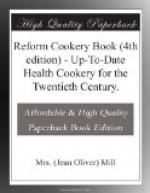Though they can be made up in a host of ways they are perhaps nicest as a simple stew. When just cooked—and great care must be taken not to overcook, for much of the substance, as well as the delicacy of flavour, is lost if we do—have a saucepan with some shred onions, sweated till tender, but not in the least coloured, in a little butter. Stir in a spoonful of flour, and when smooth a gill of milk, or the stock from the butter peas. Stir till it thickens and add the peas themselves, and any extra seasoning required. See that all is quite hot, and serve garnished with sippets of toast.
Brown Lentils
also furnish us with unlimited possibilities for new dishes. They are as yet rather difficult to procure, but need only to be known to become very popular. They somewhat resemble German lentils, but are much browner and smaller. Being so small, extra trouble must be taken to see that they are clean and free from grit. They can be used in place of German lentils for any of the soups or savouries for which recipes are given. They cook very quickly, and care must be taken with them also not to waste any of their goodness up the chimney.
Toad-in-a-Hole.
Make the sausages the same as in previous recipe, only using brown lentils instead of German lentils. Put in a buttered pie-dish and pour over the following
Batter.
Beat up one or two eggs. Add 3 tablespoonfuls flour, and by degrees two gills milk, also seasoning of grated onion, chopped parsley, white pepper, “Extract,” &c. While
Fresh Green Peas or Beans
are to be had, one need not be confined to the dried pulses. Cook the peas, broad beans, or French beans, as directed in “Vegetables.” Serve with poached or buttered eggs, fried or baked tomatoes, &c.
One might go on ad infinitum to suggest further combinations and variations of the different pulse foods, but these must be left to suggest themselves, for I must now pass on to another class of foods.
NUT FOODS.
We are only beginning very slowly to recognise the valuable properties of nuts and their possibilities in the cuisine. Indeed, there is a rather deep-rooted prejudice against them as food, people having been so long accustomed to regard them as an unconsidered trifle to accompany the wine after a big dinner, and as in this connection they usually call up visions of dyspepsia, many people regard the idea of their bulking at all largely in a meal with undisguised horror. I remember a lady saying to me that she was quite sure a meal composed to any extent of nuts would kill her, for if she took even one walnut after dinner it gave her such pain. That rather reminds one of the story of a half-witted fellow who used to go about the country doing odd jobs, and asking in return a meal and a shake-down of straw or hay.




